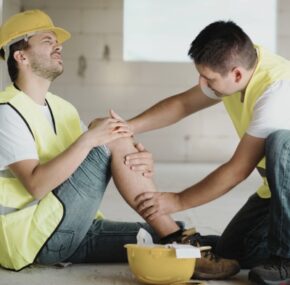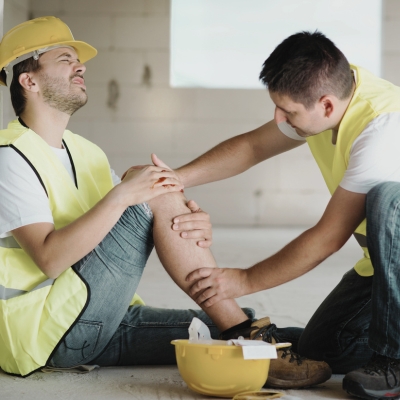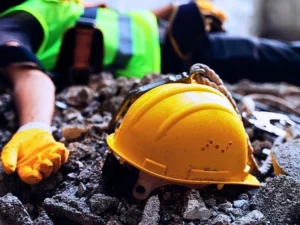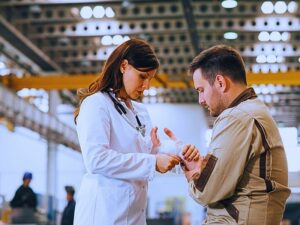In a construction accident, liability for the incident can vary depending on the circumstances of the accident. Several parties may potentially be held liable, and it often requires a thorough investigation to determine who is responsible. Some parties who may be liable for construction accidents include employers, subcontractors, property owners, engineers, or in some cases product manufacturers. An Illinois construction accident attorney can assess the details of the accident and help identify the responsible parties.

The Most Common Types of Heavy Equipment Accidents
In construction, various types of heavy equipment are commonly used to perform a wide range of tasks. Construction accidents can involve various types of heavy equipment. Some of the most commonly reported incidents involve the following types of heavy equipment:
- Excavators: Accidents involving excavators can occur due to rollovers, especially when working on uneven or unstable ground. Collisions with workers or nearby objects, especially in tight spaces, can also lead to accidents. Excavators, and other earth moving equipment, are some of the most dangerous for construction workers. In fact, due to their size and power, most earth moving equipment accidents result in fatality.
- Bulldozers: Bulldozer accidents can result from overturning, especially on slopes or uneven terrain. Collisions with other vehicles or structures and accidents caused by limited visibility are also common.
- Cranes: Crane accidents can be particularly severe due to the size and weight of the equipment involved. Accidents may occur due to collapses, mechanical failures, improper operation, or contact with power lines.
- Forklifts: Forklift accidents often involve collisions with other vehicles, workers, or stationary objects. Accidents can occur due to inadequate training, overloading, improper maintenance, or unstable loads.
- Loaders: Loader accidents can occur due to rollovers, especially when working on uneven ground or slopes. Collisions with other vehicles, workers, or structures are also potential risks.
- Scaffolding: Although not a heavy equipment type, scaffolding is frequently used in construction and can be involved in accidents. Falls are one of the deadliest dangers for construction workers and can lead to severe injuries or fatalities.
Any of these types of equipment can be involved in accidents for various reasons, including operator error, inadequate training, equipment malfunctions, improper maintenance, or unsafe work conditions. Safety protocols, proper training, regular maintenance, and adherence to regulations can help minimize the risk of accidents on construction sites. In addition, all workers on construction sites, including equipment operators, should wear appropriate PPE, such as high-visibility clothing, hard hats, safety boots, and gloves, to minimize the risk of injury. Conducting regular risk assessments helps identify potential hazards, evaluate the effectiveness of existing safety measures, and implement necessary improvements to mitigate risks.
Who Can Be Considered a Liable Party in Illinois Construction Injury Cases?
Construction sites are inherently dangerous environments, and unfortunately, accidents resulting in injuries are not uncommon. When such incidents occur, determining liability becomes crucial for the injured party seeking compensation. In Illinois, construction injury cases involve multiple parties who may be held accountable for the damages caused. Some parties who may be liable include:
- General Contractors
- Subcontractors
- Property Owners
- Architects and Engineers
- Manufacturers and Suppliers
- Government Entities
General Contractors
As the party responsible for overseeing the entire construction project, the general contractor plays a significant role in ensuring safety measures are implemented. The general contractor has a duty to maintain a safe working environment, enforce safety protocols, and provide appropriate training to workers. If the general contractor fails to fulfill these obligations, resulting in an injury, they can be held liable for negligence.
Subcontractors
Construction projects often involve subcontractors who specialize in specific tasks, such as electrical work, plumbing, or roofing. Subcontractors have a duty to perform their work safely and adhere to relevant safety standards. If a subcontractor’s negligence or failure to follow safety protocols causes an injury, they can be held liable for the damages.
Property Owners
Property owners have a legal obligation to maintain safe premises for all individuals present on the construction site. If the property owner is aware of hazardous conditions or fails to address known safety concerns, he or she may be held liable for injuries that occur as a result. The amount of responsibility that falls on the property owner varies depending on the extent of control the property owner has over the construction project.
Architects and Engineers
Architects and engineers play a crucial role in the design and planning phases of a construction project. They have a professional duty to ensure that their designs are safe and comply with building codes and regulations. If a design flaw or negligence in the planning phase leads to an injury, architects and engineers can be held liable for their contribution to the accident.
Manufacturers and Suppliers
Construction sites involve the use of various tools, machinery, and equipment, which are often provided by manufacturers and suppliers. If a defective product causes an injury, the manufacturer or supplier of that product may be held liable under product liability laws. It is essential to establish that the defect was present when the product left the manufacturer’s control and that it directly caused the injury.
Government Entities
In some cases, construction projects are overseen or contracted by government entities, such as municipalities or state agencies. These entities have a duty to ensure that the construction site meets safety regulations and that contractors adhere to proper protocols. If the negligence or failure to enforce safety measures on behalf of the government entity results in an injury, they can be held liable.
Heavy Equipment Injuries on Construction Sites
Construction sites can be dangerous environments where heavy machinery and equipment play a pivotal role in completing projects efficiently. While these machines greatly enhance productivity, they also pose significant risks to the workers involved. Heavy equipment injuries can result in severe consequences, such as serious injuries, disabilities, and even fatalities. If you have been injured in a construction accident, you may be wondering who you can prove liability and receive compensation for your injuries.
Proving liability for a construction site accident can be a complex process, but there are several steps you can take to help you prove your case.
First, you will want to document the accident scene. As soon as possible after the accident, document the scene by taking photographs or videos that capture the conditions, equipment involved, and any visible hazards. These visual records can be crucial evidence later.
You will also want to gather witness statements. Identify and interview witnesses who were present at the time of the accident. Their statements can provide valuable insights into what happened and help establish liability. You should also preserve any physical evidence related to the accident, such as damaged equipment, tools, or materials. This evidence can support your claim and help establish liability.
It is important to obtain any relevant documentation, including accident reports, safety records, inspection logs, and construction plans, as they can provide essential information about the circumstances leading to the accident.
After a heavy equipment accident, you will want to consult a construction accident attorney that can provide legal guidance, help assess the strength of your claim, and assist with gathering evidence and building your case.
Proving Liability in a Construction Accident
To prove liability in a construction accident, you must establish that the responsible party was negligent. This typically requires demonstrating the following elements:
- Duty of Care: Establish that the responsible party had a legal duty to maintain a safe environment or provide a standard of care.
- Breach of Duty: Show that the responsible party breached their duty by failing to fulfill their obligations, such as violating safety regulations, inadequate training, or improper maintenance of equipment.
- Causation: Establish a causal link between the breach of duty and the accident, demonstrating that the negligent actions or omissions directly led to the injuries sustained.
- Damages: Provide evidence of the injuries, damages, and losses suffered as a result of the accident, including medical records, bills, and statements from medical professionals.
In complex cases, expert witnesses can provide professional opinions and analysis regarding industry standards, safety practices, or the cause of the accident. Their testimony can strengthen your case and support your claim of liability. Depending on the circumstances, you may engage in negotiations with the responsible party’s insurance company or proceed with a lawsuit. An experienced construction accident attorney can guide you through this process and advocate for your rights.
Be mindful of the statute of limitations for filing a personal injury claim. In Illinois, the time limit is generally two years from the date of the accident, but it is crucial to consult with an attorney to understand the specific deadlines applicable to your case.
Proving liability for a construction site accident requires a thorough investigation, strong evidence, and legal expertise. Working with an experienced attorney can significantly enhance your chances of establishing liability and obtaining the compensation you deserve for your injuries and losses.







